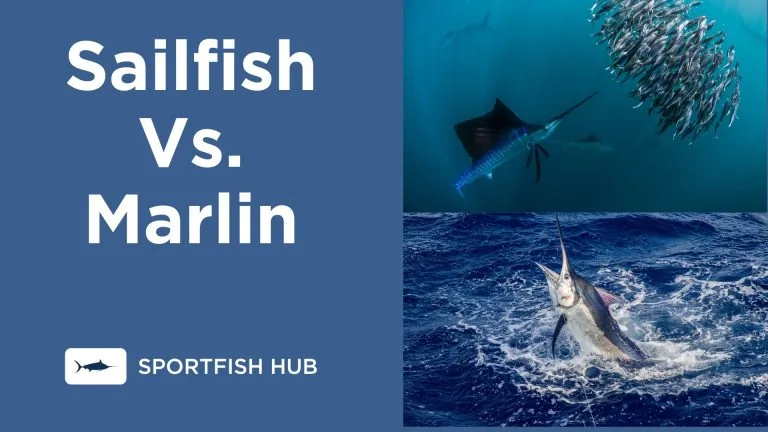Are you curious about the difference between marlin and sailfish?
Whether you’re working on a school project, a novice fisherman, or an experienced angler looking to catch one of these amazing billfish, this article is for you.
We’ll explore key differences in appearance, speed, habits, habitats, and techniques for catching sailfish and marlin. You’ll learn how to tell these two remarkable fish apart and better understand their behavior.
- Key Takeaways
- Sailfish Vs. Marlin Comparison Table
- Physical Differences
- Speed: Sailfish vs. Marlin
- Behavioral Differences: Sailfish vs. Marlin
- What Do Sailfish and Marlin Eat?
- Habitat
- Fishing Techniques and Tips
- Taste: Comparing Sailfish and Marlin
- Conclusion
- FAQ
- Are marlin and sailfish the same thing?
- Catching Marlin vs. Sailfish: Which is Easier?
- Do Sailfish fight hard when caught?
- Can Sailfish impale you?
Key Takeaways
- Physical Differences: Sailfish have a large sail-like dorsal fin and a streamlined body, while marlin have a curved, pointed dorsal fin and a robust body shape. Sailfish can grow up to 10 feet and weigh up to 220 pounds, while some blue marlin can weigh over 1300 pounds.
- Speed: Sailfish are considered the fastest fish in the ocean, reaching speeds of up to 68 miles per hour. Marlin generally swim at a slightly slower pace, with speeds of around 50 miles per hour.
- Behavioral Differences: Sailfish are known for their group hunting behavior, using their sail-like dorsal fins to corral schools of smaller fish. Marlin typically hunt alone, relying on their strength and speed to catch prey.
- Habitat: Sailfish are typically found in warm, shallow waters, often near coastal areas. Marlin prefer deep waters and are more likely to be found in the open ocean.
- Fishing Techniques: When targeting sailfish, using live bait such as ballyhoo or pilchards can be highly effective. Marlin fishing often involves trolling with large artificial lures or rigged baits like mackerel or squid.
- Taste: Sailfish have a meaty texture and a flavor that varies from very fishy to milder. Marlin have a steak-like texture and a milder flavor than swordfish but stronger than tuna.
Sailfish Vs. Marlin Comparison Table
Below we have created a simple and easy-to-reference table to display the differences between Marlin and Sailfish:
| Feature | Sailfish | Marlin |
|---|---|---|
| Hunting Technique | Cooperative hunting, corral smaller fish using sail-like dorsal fins | Solo hunters, chase down prey by leaping out of the water |
| Swimming Agility | Fastest fish in the ocean, quick and agile with streamlined bodies | Strong and powerful swimmers with muscular bodies |
| Speed | Up to 68 mph | Up to 50 mph (80 mph for black marlin) |
| Taste | Meaty consistency, varies from fishy to milder flavors | Mild flavor, steak-like texture, between swordfish and tuna |
| Habitat | Warm and temperate waters, both coastal and open ocean | Warm and temperate waters, usually found in open ocean |
| Fishing Techniques | Trolling with live bait, kite fishing, fly fishing | Trolling with lures, live bait, or dead bait; deep dropping |
| Physical Differences | Large sail-like dorsal fin, slender body, smaller size (up to 10 ft) | Pointed, curved dorsal fin, more robust body, larger size (up to 16 ft or more) |
Physical Differences
Fins
One of the most noticeable physical differences between sailfish and marlin is their fins:
- Sailfish: These majestic fish are known for their large sail-like dorsal fin that extends nearly the entire length of their body. This impressive fin not only makes sailfish easily identifiable but also contributes to their remarkable speed and agility in the water.
- Marlin: In contrast, marlin have a curved, pointed dorsal fin reminiscent of a shark’s fin. This fin shape allows marlin to slice through the water with ease, making them powerful swimmers.
Marlin Vs. Sailfish Size
Another key difference between sailfish and marlin is their size and weight:
- Sailfish: These agile predators can grow up to 10 feet long and weigh up to 220 pounds. They are among the fastest fish in the ocean, capable of reaching speeds of over 50 miles per hour.
- Marlin: Blue marlin, a popular species among anglers, can grow much larger than sailfish. Some blue marlin have been known to weigh over 1300 pounds, making them the largest fish in the Billfish family.
Speed: Sailfish vs. Marlin
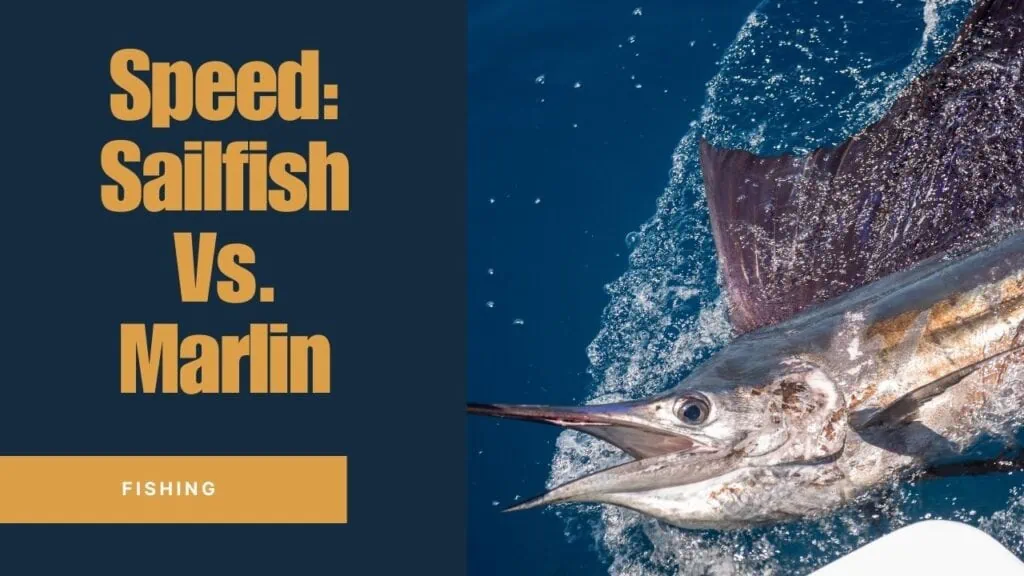
Speed is a critical factor when comparing sailfish and marlin, as both species are known for their impressive velocity in the ocean. Here’s a breakdown of their speed capabilities:
Sailfish
- Top speed: Considered the fastest fish in the ocean, reaching speeds of up to 68 miles per hour
- Predatory prowess: Highly predatory, known for their speed and agility in the water
Marlin
- Top speed: Generally clock in at a slightly slower pace than sailfish, with speeds of around 50 miles per hour
- Exception: Black marlin are said to swim up to an astonishing 80 mph (129 km/h), but this has not been proven
- Endurance: Marlin can swim for longer periods while hunting their prey, giving them an advantage in terms of stamina
- Predatory prowess: Like sailfish, marlin are highly predatory fish and are known for their speed and agility in the water
Behavioral Differences: Sailfish vs. Marlin
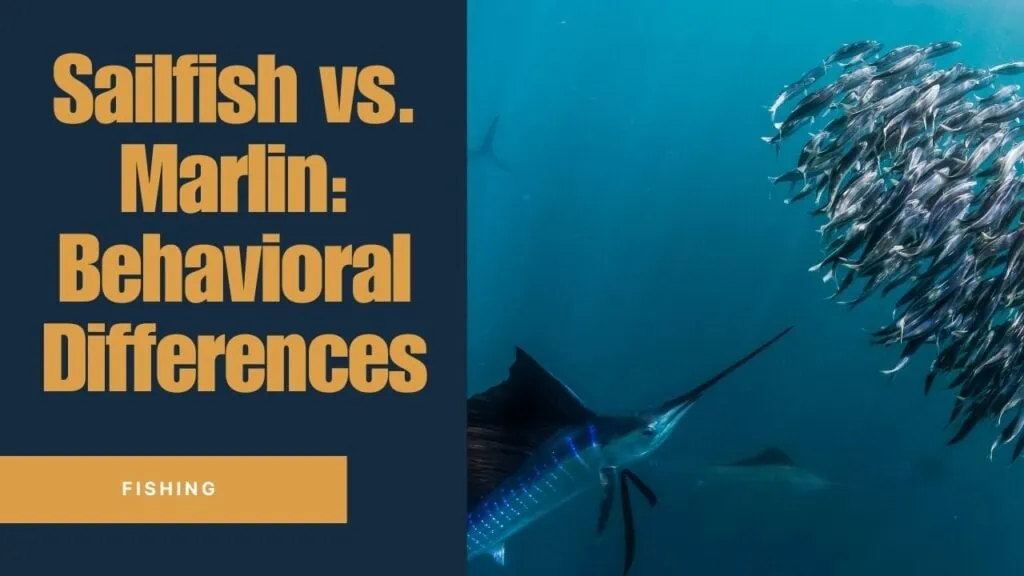
Hunting Techniques
Sailfish and marlin have distinct hunting techniques, contributing to their unique behaviors:
Sailfish
- Cooperative hunting: Sailfish are known for their group hunting behavior, working together to corral schools of smaller fish
- Dorsal fin usage: They use their sail-like dorsal fins to assist in the hunting process, making it more efficient and effective
Marlin
- Solo hunters: Marlin typically hunt alone, relying on their strength and speed to catch prey
- Pursuit tactics: They often leap out of the water to chase fast-moving fish like tuna or flying fish
What Do Sailfish and Marlin Eat?
Sailfish
As apex predators in their ecosystems, Sailfish have a diet that primarily consists of various species of fish and cephalopods. Key elements of a Sailfish’s diet include sardines, anchovies, jacks, dolphin fish, and squid.
The high-protein diet of the Sailfish contributes to their muscular physique and extraordinary speed, making them one of the fastest fish in the ocean.
Marlin
Marlin, another dominant predator in the ocean, have a diverse diet that includes a wide range of oceanic species. They feed on a variety of fish, including mackerel, tuna, and other pelagic fish species. In addition to fish, Marlin also consume squid, which are abundant in the open ocean.
The diet of the Marlin supports their robust size and strength, distinguishing them as one of the most formidable predators in the sea.
Habitat
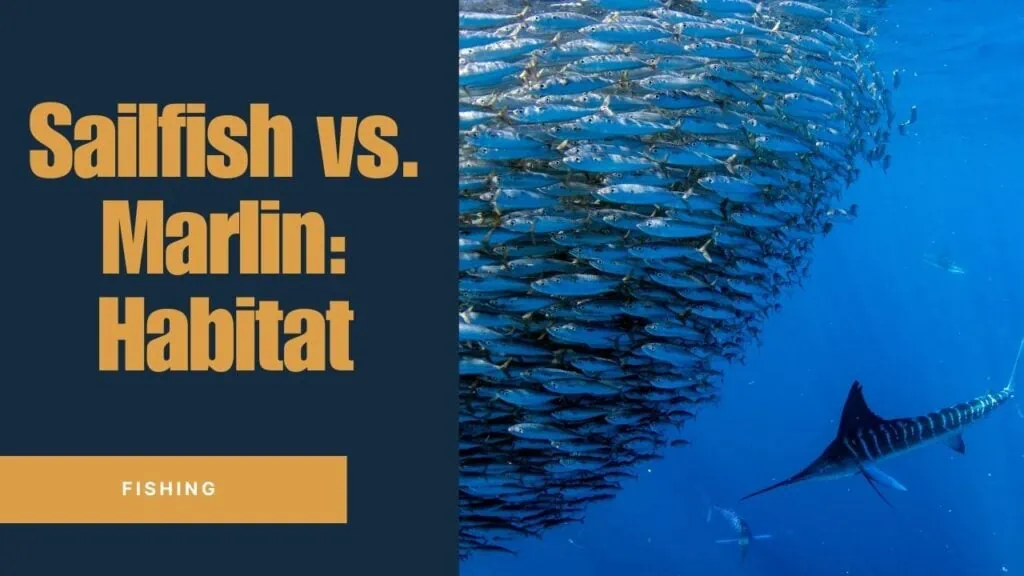
Understanding the preferred habitats of sailfish and marlin can help you distinguish between these two remarkable billfish species:
Sailfish
Sailfish are typically found in warm, shallow waters. They prefer to stay closer to the surface, where they can easily access their prey. You’re more likely to encounter sailfish near coastal areas, as they gravitate toward these regions in search of food.
Marlin
Marlin, on the other hand, generally prefer deep waters. They are more likely to be found in the open ocean, far from the shoreline. However, there is some variation among marlin species when it comes to habitat preferences:
- Blue marlin: Though blue marlin are typically found in deep waters, they sometimes venture into shallower waters in search of food or when migrating. This makes them more likely to be spotted by anglers and researchers alike.
Fishing Techniques and Tips
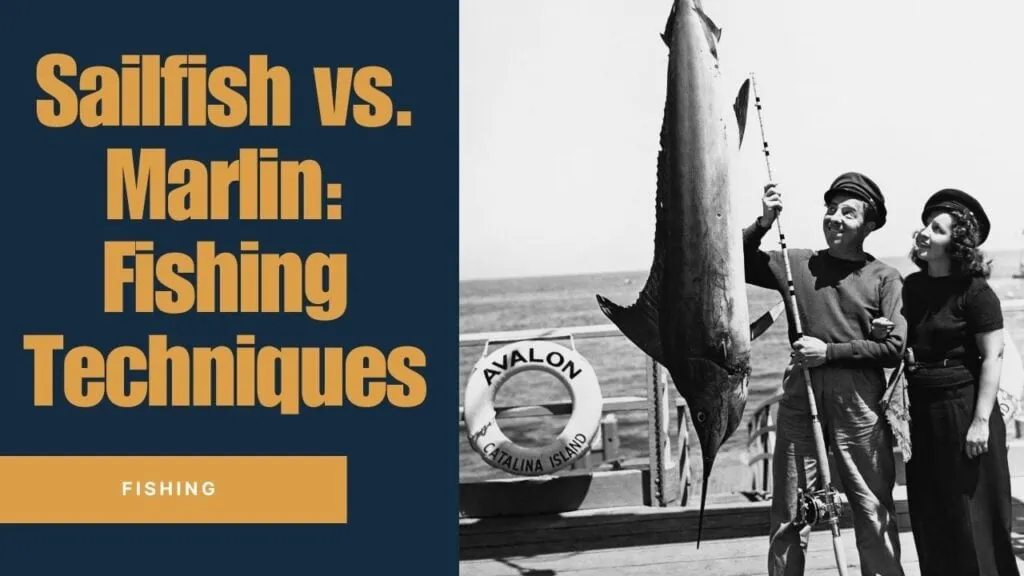
When it comes to fishing for sailfish and marlin, knowing the right techniques can make all the difference. In this section, we’ll cover essential tips for locating these magnificent fish, the best times for fishing, and the specific techniques you can use for each species.
Locating Sailfish and Marlin
To successfully locate sailfish and marlin, it’s crucial to understand their travel patterns and habits:
- Knowing their travel patterns: Both sailfish and marlin are migratory species, meaning they move in response to changes in water temperature and the availability of prey. Familiarizing yourself with their travel patterns can give you a better chance of finding them during your fishing trips.
- Spotting the fish: Keep an eye out for visual cues, like birds diving for baitfish, as this can indicate the presence of billfish beneath the surface. Additionally, watch for disturbances in the water, such as splashes or color changes, which could signal the presence of sailfish or marlin.
Best Times for Fishing
The ideal time for fishing sailfish and marlin can vary depending on the location and the season for Marlin fishing in that specific location. For example, here are three locations to catch Marlin and the times of the year you can find them there:
- Florida: May through October
- Cabo, Mexico: June through November (Blue and Black Marlin)
- Dominican Republic: June through October (Blue Marlin and April through June (White Marlin
Techniques for Each Species
Different fishing techniques work best for sailfish and marlin:
- Sailfish: When targeting sailfish, using live bait such as ballyhoo or pilchards can be highly effective. Trolling with lures or rigged baits can also work well. Make sure to use lighter tackle, as sailfish are known for their speed and acrobatics. Circle hooks are recommended to increase the chances of a successful catch and release.
- Marlin: Marlin fishing often involves trolling with large artificial lures or rigged baits like mackerel or squid. Heavy tackle is essential when targeting marlin, as they are powerful fighters. When a marlin is hooked, be prepared for an intense battle, as they’re known for their incredible leaps and long runs.
Taste: Comparing Sailfish and Marlin
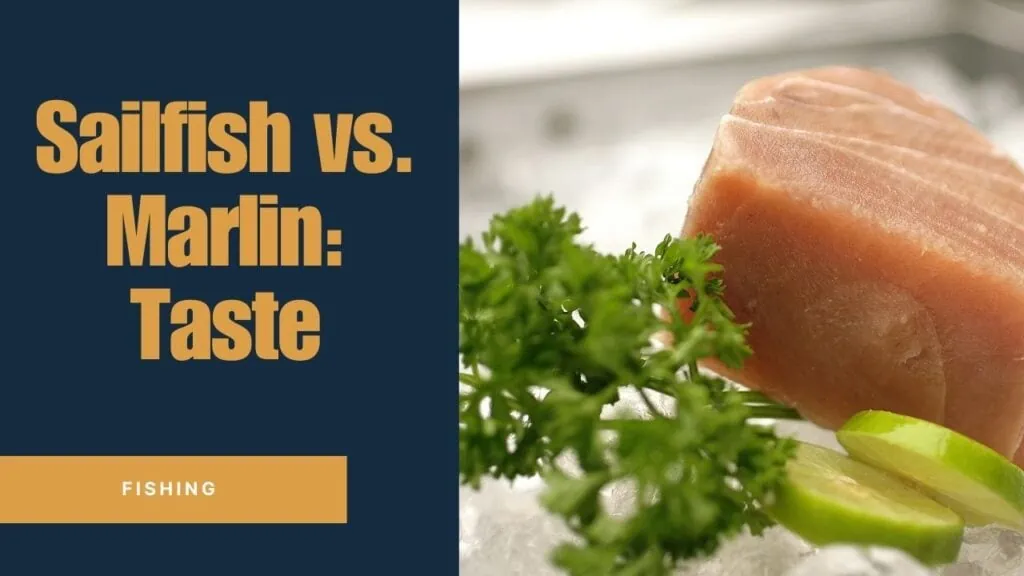
When it comes to taste and culinary uses, both sailfish and marlin offer unique experiences for seafood lovers. Let’s explore the differences in taste, texture, and cooking methods for these two billfish species:
Sailfish
- Texture: Meaty, similar to tuna and swordfish
- Flavor: Varies from very fishy to milder
- Cooking methods: Baked, fried, grilled, or used in dishes like fish tacos, smoked fish dip, or ceviche
- Pro tip: To mitigate the fishy flavor, soak the fish in brine, milk, or butter before cooking
- Popularity: Less popular than other fish for consumption, but enjoyed by those who prefer a stronger flavor
Marlin
- Texture: Steak-like, falling between swordfish and tuna
- Flavor: Milder than swordfish but stronger than tuna
- Cooking methods: Baked, grilled, poached, smoked, or used in sushi and sashimi (with diligent preparation)
- Nutrients: Rich in Vitamin B6, Vitamin B12, Calcium, and Omega-3 fatty acids
- Caution: Contains high levels of mercury; not recommended for pregnant and breastfeeding women or young children
Conclusion
In summary, sailfish and marlin are two distinct billfish species with unique characteristics. When comparing these remarkable fish, here are the key differences you should keep in mind:
- Appearance: Sailfish have a larger, sail-like dorsal fin and a more streamlined body, while marlin possess a smaller dorsal fin and a more robust body shape.
- Behavior: Sailfish are known for their incredible speed, reaching up to 50 miles per hour, and are more likely to hunt in groups. Marlin, on the other hand, are powerful and aggressive predators that typically hunt alone.
- Size: Marlin are generally larger than sailfish, with some species like the Atlantic blue marlin growing up to 14 feet in length and weighing over 2,000 pounds.
- Habitat: Sailfish prefer warmer waters near the surface, while marlin can be found in a wider range of water temperatures and depths.
- Fishing techniques: When targeting sailfish, lighter tackle and live bait are recommended, while marlin fishing typically involves trolling with large artificial lures or rigged baits and using heavy tackle.
Armed with this knowledge, you’ll be better equipped to differentiate between sailfish and marlin, whether you’re researching for a school project, planning a fishing trip, or simply seeking to learn more about these fascinating fish. Remember, understanding the unique attributes of each species is essential for successful fishing and responsible conservation efforts. Happy fishing!
FAQ
Are marlin and sailfish the same thing?
No, marlin and sailfish are not the same thing. They are both members of the Billfish family but have distinct characteristics. Sailfish have a large sail-like dorsal fin and a streamlined body, while marlin have a curved, pointed dorsal fin and a robust body shape. Sailfish are also known for their group hunting behavior, while marlin typically hunt alone.
Catching Marlin vs. Sailfish: Which is Easier?
The difficulty of catching either a marlin or a sailfish can depend on various factors, including the specific techniques used and the behavior of the fish. Sailfish are known for their speed and agility, which can make them challenging to catch. Marlin, on the other hand, are powerful fighters and can also present a significant challenge to anglers.
Do Sailfish fight hard when caught?
Sailfish are known for being extremely fast and acrobatic when caught; however, they are not very difficult to fight (When compared to Marlin) and are usually caught with very light tackle.
Can Sailfish impale you?
Yes, sailfish can absolutely impale you and have done so; however, they are not thought to do so intentionally.

